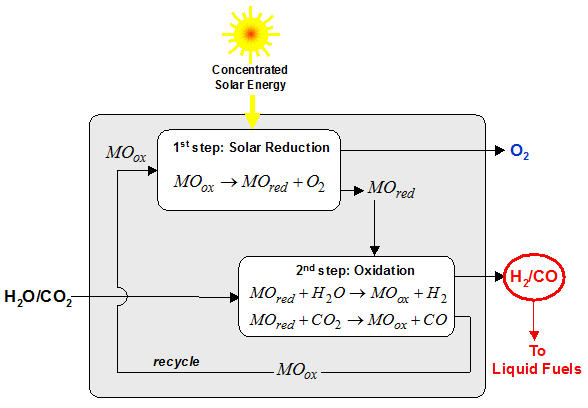Solar Splitting of H2O and CO2 via Thermochemical Redox Cycles
Funding source: external page EU-ERC, external page Swiss Federal Office of Energy, external page Swiss National Science Foundation
Doctoral students: Remo Schäppi, Sebastian Sas
Background – A 2-step thermochemical cycle based on metal oxide redox reactions is developed to split H2O and/or CO2 and produce H2 and/or CO. This redox cycle is schematically depicted in Fig. 1, and encompasses:
1st step – reduction: the solar endothermic reduction of the metal oxide into a reduced-valence metal oxide and O2 using concentrated solar energy as the source of high-temperature process heat. It is represented as:
MOox → MOred + 0.5 O2 (1)
2nd step – oxidation: the non-solar exothermic oxidation of the reduced metal oxide with H2O/CO2 which yields syngas together with the initial metal oxide; the latter is recycled to the 1st step. It is represented as:
MOred + H2O → MOox + H2 (2a)
MOred + CO2 → MOox + CO (2b)

The resulting net reactions are H2O = H2+½O2 and CO2 = CO+½O2. In contrast to direct thermolysis, H2/CO and O2 are formed in different steps thereby eliminating the need for high-temperature gas separation.
The targeted solar fuel is syngas: a mixture of H2 and CO. Syngas can be further processed to synthetic liquid hydrocarbons (e.g. diesel, kerosene, gasoline, methanol, and other alternative liquid fuels) via conventional Fischer-Tropsch or other catalytic reforming processes. Liquid hydrocarbon fuels offer exceptionally high energy densities and are convenient for the transportation sectors without changes in the current massive global infrastructure.
Links to projects on Solar Splitting of H2O and CO2
- EU-Project SOLARJET
- EU-Project SUN TO LIQUID
- CCEM Project - Solar Ceria Redox Cycle
- Virtual Institute "SolarSynGas"
Project-related Publications